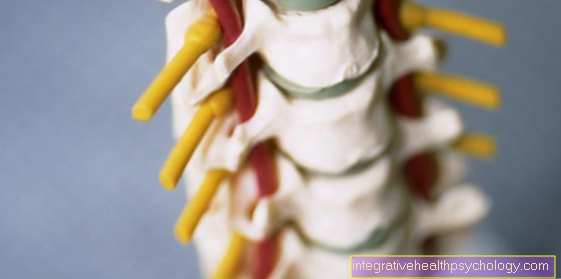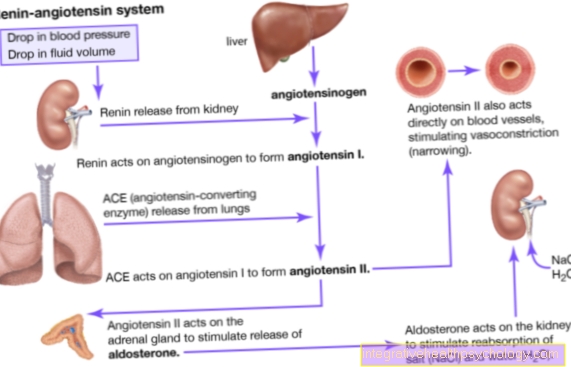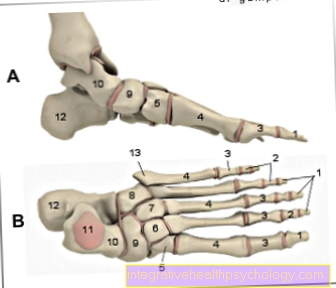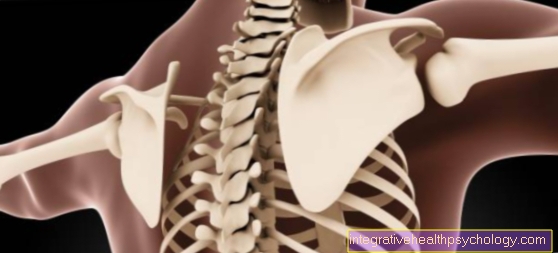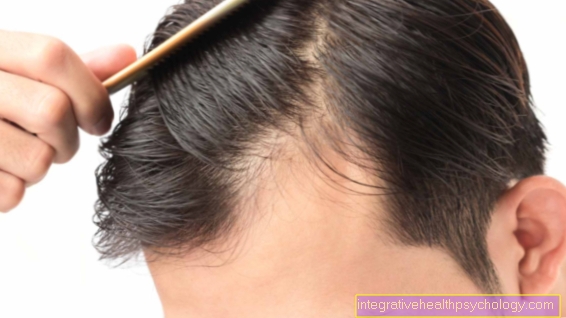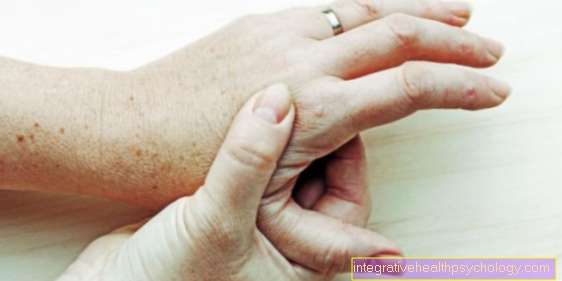Bump on forehead
introduction
A bump on the forehead is any visible or palpable protrusion in the face between the hairline and the eye area. A bump at this point usually occurs if you hit your head there before.
In most cases the bulge is harmless and will go away on its own after a while without special treatment. Only in very rare cases is a bump on the forehead necessary a medical evaluation and treatment.

Causes: An overview
The causes of a bump on the forehead are diverse:
- Blunt injury (for example, a fall)
- acne
- Insect bite
- Allergies
- Tumor (extremely rare)
Causes in detail
The most common cause of a bump on the forehead is a blunt injury. Likewise, falling forward can result in a bump on the forehead.
Skin diseases are another common cause of bumps on the forehead. Acne, which is widespread among young people, can lead to bumps on the forehead due to blocked and inflamed sebum glands.
Insect bites can also cause swelling in the forehead area. Large bumps can form on the forehead and the rest of the face, especially in the event of an allergic reaction, which can also occur due to food or pollen.
Malignant diseases are possible anywhere on the body, but extremely rare in the forehead area (with the exception of skin cancer).
Read more on the topic: Swollen forehead
After a fall
After a fall with an injury to the forehead, a bump appears in most cases.
In the forehead area, the cranial bone lies just under a thin layer of soft tissue made of skin and fatty tissue, which is squeezed when injured. As a result, tissue water flows in and creates the bump.
If a blood vessel is injured in the fall, there is also a bruise. This shows up as a bruise in the area of the bump. Over the course of a few days, the fluid is reabsorbed by the body and the blood is broken down. The bump on the forehead becomes smaller and smaller and the color of the bruise changes from green to yellow until it finally disappears.
In the case of a bump on the head that has arisen after a fall, it should always be remembered that the brain can be affected by a concussion. With symptoms like
- A headache,
- Dizziness,
- Nausea,
a doctor should therefore be consulted.
Blocked or inflamed sebum gland
A bump on the forehead can form due to a blocked or inflamed sebum gland. The skin disease acne, in particular, is widespread among young people between 15 and 25 and can lead to pathological changes in the sebum glands that are particularly common on the forehead.
In most cases, acne is milder and only normal pimples form. If bumps develop on the forehead due to abnormal changes in the sebum glands, treatment should be given by a dermatologist. Without therapy, large scars often remain when the bumps heal.
Read more on the topic:
- Clogged sebum glands - what to do?
- Home remedies for acne
tumor
A bump on the forehead shouldn't be thought of as a malignant tumor. Even if it is one of the possible causes, it is extremely rare. If a bump on the forehead is the only complaint, in most cases the underlying cause is benign.
Only in the case of noticeable skin changes and very hard, difficult to move bumps should an examination by a doctor be carried out to rule out cancer or at least to detect it in good time.
This topic might interest you: How do you recognize skin cancer?
Concomitant symptoms
The most common accompanying symptom of a bump on the forehead is pain. If the bump is caused by a fall or bumping the head, the pain is sharp and light at first and then turns into dull and throbbing. As a rule, the pain is also localized in the area of the bump on the forehead.
However, a severe injury can also cause pain all over the head, which can indicate a concussion. This can lead to other accompanying symptoms in addition to a bump on the forehead. In addition to dizziness, visual disturbances, nausea and vomiting can occur. A doctor should be consulted at the latest with such complaints.
If the bump on the forehead was not caused by an injury, other accompanying symptoms may occur.
An insect bite usually leads to severe itching. An allergic reaction can be accompanied by shortness of breath and circulatory problems. Here, too, a doctor should be called as soon as possible!
Bumps on the forehead due to blocked sebum glands in acne can be accompanied by a feeling of pressure in the affected area.
Read more on the topic: concussion
diagnosis
In most cases, diagnosing a bump on the forehead is not difficult. The doctor asks how long the bump has existed and whether there was a trigger. Since in most cases an injury from bumping or a fall is the cause, no further diagnostic steps are usually required.
If necessary, the doctor will palpate the bump and in most cases can calm the patient down and send the patient home with instructions to cool the bump. However, if the patient reports severe dizziness, visual disturbances or nausea on their own initiative or when asked, this may be evidence of a concussion.
The doctor then usually carries out an orienting neurological examination and decides how to proceed depending on the findings. In the event of abnormalities, admission to hospital for imaging and monitoring may be required.
treatment
In most cases, no special therapy is required for a bump on the forehead, as it will resolve on its own. If you hit your head, it is helpful to cool the affected area immediately if possible.
In the further course, you should always cool the bump on the forehead for a few minutes, for example with an ice pack wrapped in a kitchen towel.
In the case of a severe injury that also triggered headaches or dizziness, you should also take it easy for some time until you feel better again. However, you should not lie flat, as this will make it difficult for the tissue water to be transported back out of the bump. Other types of bumps on the forehead may sometimes require a special form of therapy.
If this is caused by blocked sebum glands as part of an acne disease, treatment should be given by a dermatologist. They can either prescribe an ointment or tablets to improve the complexion and thus prevent new bumps on the forehead.
From a medical point of view, a bump due to a benign growth such as fatty tissue, i.e. a lipoma, usually does not need to be treated at all. However, therapy can be considered for cosmetic reasons. The bump on the forehead is then surgically removed as part of a minor intervention. This can usually be done on an outpatient basis, so you don't have to stay in hospital.
Also read:
- Acne- This works best
- What to do about a bruise
Duration
Most bumps on the forehead are short-lived.If the cause was an injury such as hitting your head on an edge, the lump will slowly recede over a few days until it disappears completely. A bruise that may have occurred at the same time can persist for a few days longer.
The duration can be influenced somewhat by cooling the affected area immediately after the injury. In addition, you should not lie completely flat when sleeping, but with your upper body slightly elevated. This promotes the removal of the water retention responsible for the bump on the forehead.
For other types of bumps, the duration may vary. If a new bump appears and lasts for more than two weeks, a doctor should be examined.


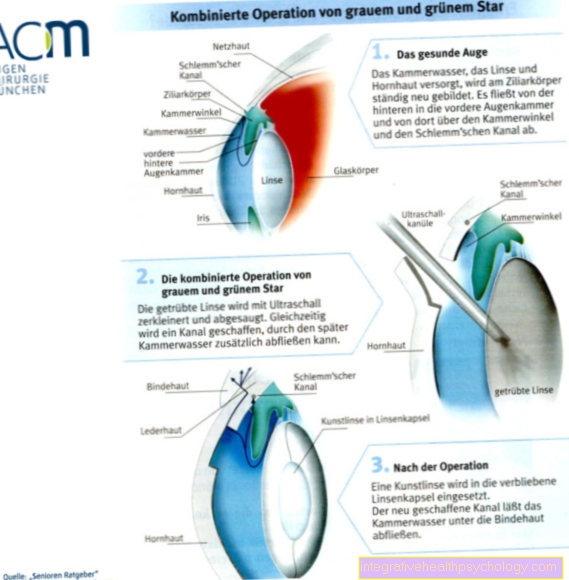





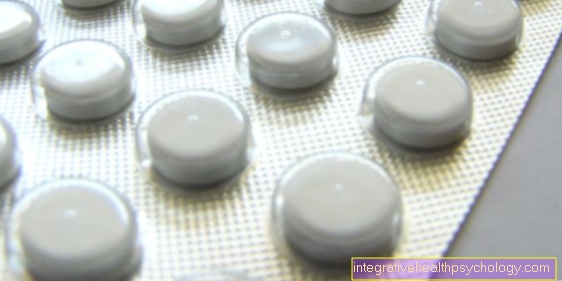
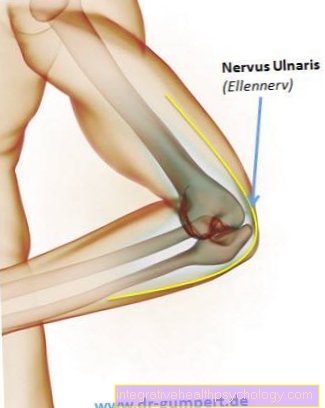
.jpg)
